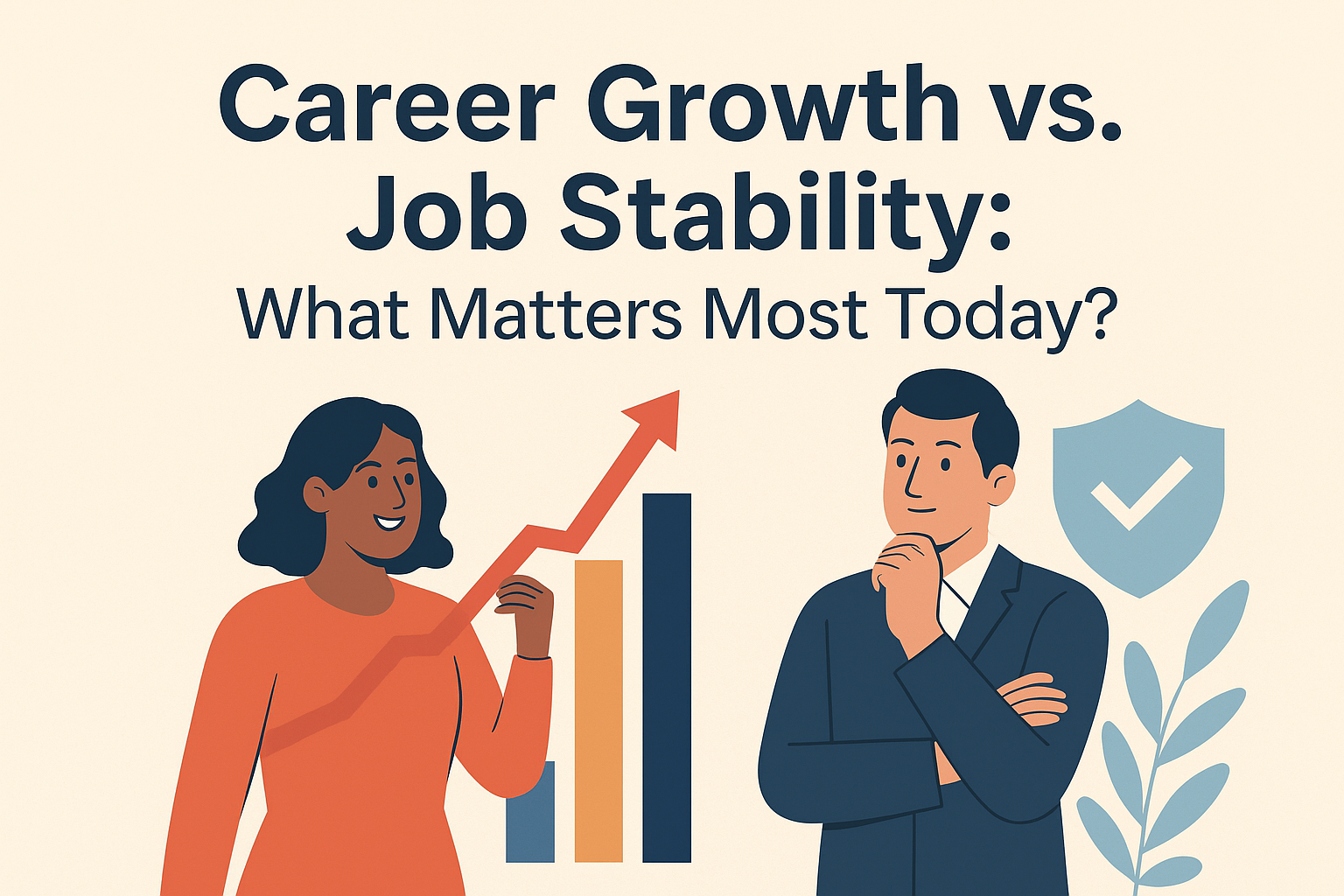Career Growth vs. Job Stability: What Matters Most Today?

Once upon a time, job stability was the ultimate goal. People sought long-term security, pensions, and predictable routines. But the modern workforce in 2025 is different. The rise of gig work, rapid tech evolution, remote flexibility, and economic uncertainty have changed how professionals view their careers.
Now, many are torn between two priorities:
- Career growth – advancing roles, learning new skills, increasing income
- Job stability – steady employment, minimal risk, and reliable paychecks
So, which matters more? And how do you choose what’s right for your stage of life, industry, and goals?
In this blog, we’ll explore:
- The pros and cons of both paths
- How age, industry, and personality play a role
- Why the old definition of “stability” is outdated
- A real-life case study
- Practical frameworks to help you decide
Let’s help you build a career that works for your life—not just your resume.
1. Defining Career Growth and Job Stability
✅ Career Growth involves:
- Promotions and title advancements
- Developing new skills or certifications
- Taking on stretch assignments or leadership roles
- Increasing your market value and income
✅ Job Stability offers:
- A steady paycheck
- Low risk of layoffs or restructuring
- Predictability in work, location, and hours
- Often comes with benefits and retirement plans
Key Insight: Growth and stability aren’t always mutually exclusive—but chasing one may limit the other.
2. The Pros and Cons of Career Growth
Pros:
- Increases your income potential over time
- Keeps your skills sharp and relevant
- Enhances confidence and job satisfaction
- Opens doors to bigger opportunities (and networks)
Cons:
- Often involves more stress or workload
- Can require relocation, job changes, or instability
- May demand sacrifices in personal life (especially during transitions)
Read more: How to Stand Out at Work (Without Burning Out)
3. The Pros and Cons of Job Stability
Pros:
- Predictable schedule and financial peace of mind
- Lower risk and less pressure to constantly perform
- More time for personal goals or family
Cons:
- Risk of stagnation or skill decay
- Lower salary growth potential
- May lead to disengagement or career boredom
- False sense of security (no job is truly “safe” anymore)
4. What Matters Most in 2025? Trends to Consider
- The average job tenure is now 4.1 years globally (source: LinkedIn)
- Layoffs and AI disruption are making long-term “stability” more volatile
- Employers now value adaptability and continuous learning more than tenure
- Workers under 35 prioritize growth and flexibility over security
Conclusion: The definition of “stability” has shifted. In today’s market, your skills and reputation are your real job security.
5. Factors That Should Influence Your Choice
Ask yourself:
✅ Stage of Life: Are you starting out, supporting a family, or nearing retirement?
✅ Risk Tolerance: Do you thrive on change or prefer predictability?
✅ Financial Position: Can you afford temporary instability? Do you have savings?
✅ Values: Do you value purpose, autonomy, or consistency?
✅ Industry Trends: Are you in a growing or shrinking sector?
Example: Tech professionals may lean toward growth due to fast-changing skills, while healthcare workers may prioritize stability due to steady demand.
6. Can You Have Both? Hybrid Career Strategies
It’s possible to balance both—if you’re intentional.
✅ Scenario 1: Stay in a stable role but grow sideways
- Lead cross-functional projects
- Take certifications (e.g., via Coursera)
- Mentor others or train new employees
✅ Scenario 2: Side Hustles and Consulting
✅ Scenario 3: Internal Career Mobility
- Apply for new roles within your current company
- Many companies now have “talent marketplaces” for internal gigs
Read more: How to Create a Job Search Routine That Gets Results
7. Signs You’re Ready to Prioritize Career Growth
- You feel bored or underused in your current job
- You want to increase your income or take on leadership
- You’re curious about other industries or functions
- You’ve stopped learning or being challenged
Checklist:
- Do I know where I want to be in 3–5 years?
- Am I willing to sacrifice short-term comfort for long-term value?
- Have I invested in updating my resume, LinkedIn, or certifications?
Tool: Use Teal to track goals, skills, and opportunities.
8. Signs You May Need Stability (for Now)
- You're going through a major life change (move, parenthood, illness)
- Financial stress is a top concern
- You’re feeling emotionally or physically exhausted
- You value routine, structure, and predictability right now
Reminder: Stability isn’t settling. It can be a smart seasonal strategy.
9. Case Study: Growth vs. Stability in Real Life
Background: Nadia, a marketing coordinator in Dubai, worked at a multinational company with great benefits and job security. After 3 years, she felt stuck—doing repetitive tasks and receiving minimal feedback.
Option A (Stability): Stay in her role with incremental raises Option B (Growth): Accept a startup marketing lead role—higher risk, more learning
What She Did:
- Took a skills audit and realized she was under-leveraged
- Built a financial cushion for 3 months of transition
- Accepted the growth role with a 20% pay increase and broader scope
Outcome:
- First 3 months were tough, but she quickly built a new skillset
- Now mentors early-career marketers and teaches workshops on strategy
- Says it was “the smartest scary move” she ever made
Takeaway: Growth often requires discomfort—but discomfort doesn’t last forever.
10. Final Thoughts: The Right Choice Is a Personal One
The answer to “What matters more: career growth or job stability?” isn’t universal. It’s personal. It’s also fluid—your answer today might be different in a year.
✅ If you feel stuck, underpaid, or invisible—explore growth
✅ If life is turbulent and you need peace—honor the need for stability
✅ If you can, build your stability by growing smartly
Ultimately, your career should support your life—not run it. Make decisions from clarity, not fear.
Subscribe to UJ+ for weekly career clarity, modern strategies, and real-world stories to help you grow—on your terms.

